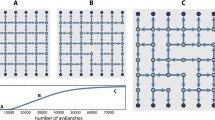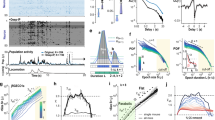Abstract
How cortical neurons process information crucially depends on how their local circuits are organized. Spontaneous synchronous neuronal activity propagating through neocortical slices displays highly diverse, yet repeatable, activity patterns called “neuronal avalanches”. They obey power-law distributions of the event sizes and lifetimes, presumably reflecting the structure of local circuits developed in slice cultures. However, the explicit network structure underlying the power-law statistics remains unclear. Here, we present a neuronal network model of pyramidal and inhibitory neurons that enables stable propagation of avalanche-like spiking activity. We demonstrate a neuronal wiring rule that governs the formation of mutually overlapping cell assemblies during the development of this network. The resultant network comprises a mixture of feedforward chains and recurrent circuits, in which neuronal avalanches are stable if the former structure is predominant. Interestingly, the recurrent synaptic connections formed by this wiring rule limit the number of cell assemblies embeddable in a neuron pool of given size. We investigate how the resultant power laws depend on the details of the cell-assembly formation as well as on the inhibitory feedback. Our model suggests that local cortical circuits may have a more complex topological design than has previously been thought.







Similar content being viewed by others
References
Abbott LF, Rohrkemper R (2006) A simple growth model constructs critical avalanche networks. Prog. Brain Res. in press.
Abeles M (1991) Corticonics: Neural Circuits of the Cerebral Cortex. Cambridge University Press, Cambridge.
Alsina B, Vu T, Cohen-Cory S (2001) Visualizing synapse formation in arborizing optic axons in vivo: dynamics and modulation by BDNF. Nat. Neurosci. 4: 1093–1101.
Amari S (1988) Associative memory and its statistical neurodynamical analysis. In: Neural and synergetic computers. Haken H (ed.) Springer-Verlag, Berlin, pp. 85–99.
Amit DJ, Gutfreund H, Sompolinsky H (1985) Storing infinite numbers of patterns in a spin-glass model of neural networks. Phys. Rev. Lett. 55: 1530–1533.
Aviel Y, Horn D, Abeles M (2005) Memory capacity of balanced networks. Neural Comp. 17: 691–713.
Barabasi AL, Albert R (1999) Emergence of scaling in random networks. Science 286: 509–512.
Beggs JM, Plenz D (2003) Neuronal avalanches in neocortical circuits. J. Neurosci. 23: 11167–11177.
Beggs JM, Plenz D (2004) Neuronal avalanches are diverse and precise activity patterns that are stable for many hours in cortical slice cultures. J. Neurosci. 24: 5216–5229.
Bi G, Poo M (2001) Synaptic modification by correlated activity: Hebb's postulate revisited. Annu. Rev. Neurosci. 24: 139–166.
Braitenberg V, Schuz A (1998) Cortex: Statics and Geometry of Neuronal Connectivity. Springer-Verlag, Berlin.
Brunel N (2000) Dynamics of sparsely connected networks of excitatory and inhibitory spiking neurons. J. Comput. Neurosci. 8: 183–208.
Cateau H, Fukai T (2001) Fokker-Planck approach to the pulse packet propagation in synfire chain. Neural Netw. 14: 675–685.
Corral A, Perez CJ, Diaz-Guilera A, Arenas A (1995) Self-organized criticality and synchronization in a lattice model of integrate-and-fire oscillators. Phys. Rev. Lett. 74: 118–121.
Diesmann M, Gewaltig M, Aertsen A (1999) Stable propagation of synchronous spiking in cortical neural networks. Nature 402: 529–533.
Eurich CW, Herrmann JM, Ernst UA (2002) Finite-size effects of avalanche dynamics. Phys. Rev. E 66: 066137-1-15
Foldy C, Dyhrfjeld-Johnsen J, Soltesz I (2005) Structure of cortical microcircuit theory. J. Physiol. 562: 47–54.
Gupta A, Wang Y, Markram H (2000) Organizing principles for a diversity of GABAergic interneurons and synapses in the neocortex. Science 287: 273–278.
Hahnloser RH, Kozhevnikov AA, Fee MS (2002) An ultra-sparse code underlies the generation of neural sequences in a songbird. Nature 419: 65–70. Erratum in: Nature (2003) 421: 294.
Harris TE (1989) The Theory of Branching Processes. Dover, New York.
Hensch TK, Stryker MP (2004) Columnar architecture sculpted by GABA circuits in developing cat visual cortex. Science 303: 1678–1681.
Holmgren C, Harkany T, Svennenfors B, Zilberter Y (2003) Pyramidal cell communication within local networks in layer 2/3 of rat neocortex. J. Physiol. 551: 139–153.
Hopfield JJ (1982) Neural networks and physical systems with emergent collective computational abilities. Proc. Natl. Acad. Sci. U.S.A. 79: 2554–2558.
Ikegaya Y, Aaron G, Cossart R, Aronov D, Lampl I, Ferster D, Yuste R (2004) Synfire chains and cortical songs: temporal modules of cortical activity. Science 304: 559–564.
Izhikevich EM (2004) Which model to use for cortical spiking neurons? IEEE Trans. Neural. Netw. 15: 1063–1070.
Izhikevich EM, Gally JA, Edelman GM (2004) Spike-timing dynamics of neuronal groups. Cereb. Cortex 14: 933–944.
Kalisman N, Silberberg G, Markram H (2005) The neocortical microcircuit as a tabula rasa. Proc. Natl. Acad. Sci. U.S.A. 102: 880–885.
Khazipov R, Sirota A, Leinekugel X, Holmes GL, Ben-Ari Y, Buzsaki G (2004) Early motor activity drives spindle bursts in the developing somatosensory cortex. Nature 432: 758–761.
Kimpo RR, Theunissen FE, Doupe AJ (2003) Propagation of correlated activity through multiple stages of a neural circuit. J. Neurosci. 23: 5750–5761.
Kitano K, Cateau H, Fukai T (2002) Self-organization of memory activity through spike-timing-dependent plasticity. Neurorep 13: 795–798.
Kitano K, Fukai T (2004) Temporal characteristics of the predictive synchronous firing modeled by spike-timing-dependent plasticity. Learn. Mem. 11: 267–276.
Levina A, Herrmann JM, Geisel T (2006) Dynamical Synapses give rise to a power-law distribution of neuronal avalanches. Adv. in Neural Information Processing Systems.
Levy N, Horn D, Meilijson I, Ruppin E (2001) Distributed synchrony in a cell assembly of spiking neurons. Neural Netw. 14: 815–824.
Mataga N, Mizuguchi Y, Hensch TK (2004) Experience-dependent pruning of dendritic spines in visual cortex by tissue plasminogen activator. Neuron 44: 1031–1041.
Mehring C, Hehl U, Kubo M, Diesmann M, Aertsen A (2003) Activity dynamics and propagation of synchronous spiking in locally connected random networks. Biol. Cybern. 88: 395–408.
Moradi F (2004) Information coding and oscillatory activity in synfire neural networks with and without inhibitory coupling. Biol. Cybern. 91: 283–294.
Peinado A (2000) Traveling slow waves of neural activity: a novel form of network activity in developing neocortex. J. Neurosci. 20: RC54:1–6.
Prut Y, Vaadia E, Bergman H, Haalman I, Slovin H, Abeles M (1998) Spatiotemporal structure of cortical activity: properties and behavioral relevance. J. Neurophysiol. 79: 2857–2874.
Reyes AD (2003) Synchrony-dependent propagation of firing rate in iteratively constructed networks in vitro. Nat. Neurosci. 6: 593–599.
Rolls ET, Treves A (1998) Neural Networks and Brain Function. Oxford University Press, New York.
Shiino M, Fukai T (1993) Self-consistent signal-to-noise analysis of the statistical behavior of analog neural networks and enhancement of the storage capacity. Phys. Rev. E 48: 867–897.
Sompolinsky H, Kanter I (1986) Temporal association in asymmetric neural networks. Phys. Rev. Lett. 57: 2861–2864.
Stepanyants A, Tams G, Chklovskii DB (2004) Class-specific features of neuronal wiring. Neuron 43: 251–259.
Stewart CV, Gerfen CR, Plenz D (2004) Dopamine facilitates “neuronal avalanches” and “synfire chains” in layer 2/3 of rat somatosensory cortex slices. Abs. Soc. Neurosci.
Teramae J, Fukai T (2005) Neuronal avalanches as a probe for cortical circuit structure. Abs. Soc. Neurosci.
Uesaka N, Hirai S, Maruyama T, Ruthazer ES, Yamamoto N (2005) Activity dependence of cortical axon branch formation: a morphological and electrophysiological study using organotypic slice cultures. J. Neurosci. 25: 1–9.
Vogels TP, Rajan K, Abbott LF.. (2005) Neural network dynamics. Annu. Rev. Neurosci. 28: 357–376.
Yoshimura Y, Dantzker JLM, Callaway EM (2005) Excitatory cortical neurons form fine-scale functional networks. Nature 433: 868–873.
Zapperi S, Baekgaard LK, Stanley HE (1995) Self-organized branching processes: mean-field theory for avalanches. Phys. Rev. Lett. 75: 4071–4074.
Acknowledgments
The authors express their sincere thanks to T. Hensch and N. Yamamoto for fruitful discussions about the development of the cortical circuits. The present work was partially supported by Grants in Aid for Scientific Research of Priority Areas and Grant-in-Aid for Young Scientists (B) from the Japanese Ministry of Education, Culture, Sports, Science and Technology.
Author information
Authors and Affiliations
Corresponding author
Additional information
Competing financial interests: The authors declare that they have no competing financial interests.
Action Editor: Peter Latham
Appendix
Appendix
The average number of synaptic connections
In the proposed model, the number of excitatory connections included in the entire network is approximately given as \(Pms\) under sparseness assumption where we can neglect a small overlap between different chains (\(P,\;s \ll N\)), where P is the total number of synfire chains, m is the number of synaptic projections to each cell, and s is the average size of these chains. The connection probability is therefore given as \(c = \frac{{Pms}}{{N^2 }}\). For a chain of average size s, the product of the probability c and the number of possible neuron pairs \(s^2\) gives the average number of non-purely feedforward (recurrent) connections in this chain, \(\frac{{Pms^3 }}{{N^2 }}\). We note that the ratio of the number of recurrent connections to that of purely feed-forward connections in this chain is \(\frac{{Pms^3 }}{{N^2 }}/ms = P\left( {\frac{s}{N}} \right)^2\). We can similarly obtain the same formula for the average number of synaptic connections between each pair of different chains. This implies that the degree of interferences between synfire chains increases with \(P\).
Rights and permissions
About this article
Cite this article
Teramae, Jn., Fukai, T. Local cortical circuit model inferred from power-law distributed neuronal avalanches. J Comput Neurosci 22, 301–312 (2007). https://doi.org/10.1007/s10827-006-0014-6
Received:
Revised:
Accepted:
Published:
Issue Date:
DOI: https://doi.org/10.1007/s10827-006-0014-6




